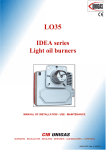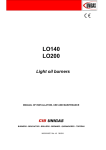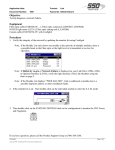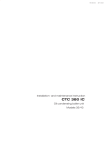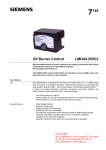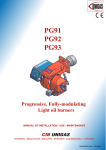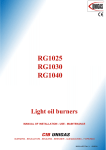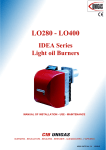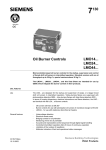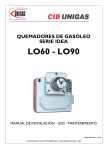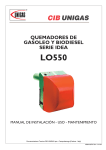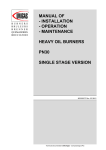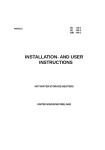Download IDEA series Light oil burners
Transcript
IDEA series Light oil burners MANUAL OF INSTALLATION - USE - MAINTENANCE www.4heat.cz TABLE OF CONTENTS WARNINGS ................................................................................................................................................................ 3 PART I: INSTALLATION ........................................................................................................................................... 5 GENERAL FEATURES ................................................................................................................................................................... 5 How to interpret the burner’s “Performance curve” ......................................................................................................................... 6 SPECIFICATIONS .......................................................................................................................................................................... 7 Performance curves ........................................................................................................................................................................ 7 Overall dimensions ......................................................................................................................................................................... 8 MOUNTINGS AND CONNECTIONS .............................................................................................................................................. 9 Packing ........................................................................................................................................................................................... 9 Electrical connections ................................................................................................................................................................... 10 Installation diagram of light oil pipes ............................................................................................................................................. 11 Light oil supply pipeline sizing ....................................................................................................................................................... 11 Monotube system .......................................................................................................................................................................... 11 Assembling the flexible light oil hoses .......................................................................................................................................... 12 About the use of fuel pumps ......................................................................................................................................................... 13 SETTINGS .................................................................................................................................................................................... 14 Oil rate adjustment ........................................................................................................................................................................ 14 Priming the pump .......................................................................................................................................................................... 14 LIGHT OIL PUMPS ....................................................................................................................................................................... 15 Air flow adjustment ........................................................................................................................................................................ 16 Combustion head adjustment ....................................................................................................................................................... 16 PART II: OPERATION ............................................................................................................................................. 18 OPERATION ................................................................................................................................................................................. 18 PART III: MAINTENANCE ....................................................................................................................................... 19 ROUTINE MAINTENANCE OPERATIONS .................................................................................................................................. 19 Disassembling the components plate ........................................................................................................................................... 19 Disassembling the nozzle ........................................................................................................................................................... 20 Replacing the electrodes .............................................................................................................................................................. 21 Checking the detection current ..................................................................................................................................................... 21 Seasonal stop ............................................................................................................................................................................... 21 TROUBLESHOOTING .................................................................................................................................................................. 22 EXTERNAL AIR INTAKE KIT ASSEMBLY (WHEN SUPPLIED).................................................................................................. 23 ELECTRICAL WIRING DIAGRAMS ............................................................................................................................................. 24 BURNER EXPLODED VIEW ........................................................................................................................................................ 28 SPARE PARTS ............................................................................................................................................................................. 30 APPENDIX ............................................................................................................................................................... 31 2 www.4heat.cz WARNINGS THIS MANUAL IS SUPPLIED AS AN INTEGRAL AND ESSENTIAL PART OF THE PRODUCT AND MUST BE DELIVERED TO THE USER. INFORMATION INCLUDED IN THIS SECTION ARE DEDICATED BOTH TO THE USER AND TO PERSONNEL FOLLOWING PRODUCT INSTALLATION AND MAINTENANCE. THE USER WILL FIND FURTHER INFORMATION ABOUT OPERATING AND USE RESTRICTIONS, IN THE SECOND SECTION OF THIS MANUAL. WE HIGHLY RECOMMEND TO READ IT. CAREFULLY KEEP THIS MANUAL FOR FUTURE REFERENCE. 1) GENERAL INTRODUCTION shall have qualified personnel carry out the following operations: a Remove the power supply by disconnecting the power cord from the mains. b) Disconnect the fuel supply by means of the hand-operated shut-off valve and remove the control handwheels from their spindles. z The equipment must be installed in compliance with the regulations in force, following the manufacturer’s instructions, by qualified personnel. z Qualified personnel means those having technical knowledge in the field of components for civil or industrial heating systems, sanitary hot water generation and particularly service centres authorised by the manufacturer. z Improper installation may cause injury to people and animals, or damage to property, for which the manufacturer cannot be held liable. z Remove all packaging material and inspect the equipment for integrity. In case of any doubt, do not use the unit - contact the supplier. The packaging materials (wooden crate, nails, fastening devices, plastic bags, foamed polystyrene, etc), should not be left within the reach of children, as they may prove harmful. z Before any cleaning or servicing operation, disconnect the unit from the mains by turning the master switch OFF, and/or through the cutout devices that are provided. z Make sure that inlet or exhaust grilles are unobstructed. z In case of breakdown and/or defective unit operation, disconnect the unit. Make no attempt to repair the unit or take any direct action. Contact qualified personnel only. Units shall be repaired exclusively by a servicing centre, duly authorised by the manufacturer, with original spare parts. Failure to comply with the above instructions is likely to impair the unit’s safety. To ensure equipment efficiency and proper operation, it is essential that maintenance operations are performed by qualified personnel at regular intervals, following the manufacturer’s instructions. z When a decision is made to discontinue the use of the equipment, those parts likely to constitute sources of danger shall be made harmless. z In case the equipment is to be sold or transferred to another user, or in case the original user should move and leave the unit behind, make sure that these instructions accompany the equipment at all times so that they can be consulted by the new owner and/or the installer. z For all the units that have been modified or have options fitted then original accessory equipment only shall be used. z This unit shall be employed exclusively for the use for which it is meant. Any other use shall be considered as improper and, therefore, dangerous. The manufacturer shall not be held liable, by agreement or otherwise, for damages resulting from improper installation, use and failure to comply with the instructions supplied by the manufacturer. Special warnings z Make sure that the burner has, on installation, been firmly secured to the appliance, so that the flame is generated inside the appliance firebox. z Before the burner is started and, thereafter, at least once a year, have qualified personnel perform the following operations: a set the burner fuel flow rate depending on the heat input of the appliance; b set the flow rate of the combustion-supporting air to obtain a combustion efficiency level at least equal to the lower level required by the regulations in force; c check the unit operation for proper combustion, to avoid any harmful or polluting unburnt gases in excess of the limits permitted by the regulations in force; d make sure that control and safety devices are operating properly; e make sure that exhaust ducts intended to discharge the products of combustion are operating properly; f on completion of setting and adjustment operations, make sure that all mechanical locking devices of controls have been duly tightened; g make sure that a copy of the burner use and maintenance instructions is available in the boiler room. z In case of a burner shut-down, reser the control box by means of the RESET pushbutton. If a second shut-down takes place, call the Technical Service, without trying to RESET further. z The unit shall be operated and serviced by qualified personnel only, in compliance with the regulations in force. 3) GENERAL INSTRUCTIONS DEPENDING ON FUEL USED 3a) ELECTRICAL CONNECTION z z z z z 2) SPECIAL INSTRUCTIONS FOR BURNERS z z The burner should be installed in a suitable room, with ventilation openings complying with the requirements of the regulations in force, and sufficient for good combustion. z Only burners designed according to the regulations in force should be used. z This burner should be employed exclusively for the use for which it was designed. z Before connecting the burner, make sure that the unit rating is the same as delivery mains (electricity, gas oil, or other fuel). z Observe caution with hot burner components. These are, usually, near to the flame and the fuel pre-heating system, they become hot during the unit operation and will remain hot for some time after the burner has stopped. When the decision is made to discontinue the use of the burner, the user For safety reasons the unit must be efficiently earthed and installed as required by current safety regulations. It is vital that all saftey requirements are met. In case of any doubt, ask for an accurate inspection of electrics by qualified personnel, since the manufacturer cannot be held liable for damages that may be caused by failure to correctly earth the equipment. Qualified personnel must inspect the system to make sure that it is adequate to take the maximum power used by the equipment shown on the equipment rating plate. In particular, make sure that the system cable cross section is adequate for the power absorbed by the unit. No adaptors, multiple outlet sockets and/or extension cables are permitted to connect the unit to the electric mains. An omnipolar switch shall be provided for connection to mains, as required by the current safety regulations. The use of any power-operated component implies observance of a few basic rules, for example: - do not touch the unit with wet or damp parts of the body and/or with bare feet; - do not pull electric cables; - do not leave the equipment exposed to weather (rain, sun, etc.) unless expressly required to do so; - do not allow children or inexperienced persons to use equipment; z The unit input cable shall not be replaced by the user. In case of damage to the cable, switch off the unit and contact qualified personnel to replace. When the unit is out of use for some time the electric switch supplying all the power-driven components in the system (i.e. pumps, burner, etc.) should be switched off. 3 www.4heat.cz DIRECTIVES AND STANDARDS Gas burners European directives: - Directive 90/396/CEE - Gas Appliances; - Directive 2006/95/EC on low voltage; - Directive 2004/108/CEE on electromagnetic compatibility Harmonised standards : -UNI EN 676 (Gas Burners; -CEI EN 60335-1(Household and similar electrical appliances - Safety. Part 1: General requirements; - EN 50165 (Electrical equipment of non-electric appliances for household and similar purposes. Safety requirements. 3b) FIRING WITH GAS, LIGHT OIL OR OTHER FUELS GENERAL z The burner shall be installed by qualified personnel and in compliance with regulations and provisions in force; wrong installation can cause injuries to people and animals, or damage to property, for which the manufacturer cannot be held liable. z Before installation, it is recommended that all the fuel supply system pipes be carefully cleaned inside, to remove foreign matter that might impair the burner operation. z Before the burner is commissioned, qualified personnel should inspect the following: a the fuel supply system, for proper sealing; b the fuel flow rate, to make sure that it has been set based on the firing rate required of the burner; c the burner firing system, to make sure that it is supplied for the designed fuel type; d the fuel supply pressure, to make sure that it is included in the range shown on the rating plate; e the fuel supply system, to make sure that the system dimensions are adequate to the burner firing rate, and that the system is equipped with all the safety and control devices required by the regulations in force. z When the burner is to remain idle for some time, the fuel supply tap or taps should be closed. Light oil burners European directives: - Directive 2006/95/EC on low voltage; - Directive 2004/108/CEE on electromagnetic compatibility Harmonised standards : -CEI EN 60335-1(Household and similar electrical appliances - Safety. Part 1: General requirements; - EN 50165 (Electrical equipment of non-electric appliances for household and similar purposes. Safety requirements. National standards : -UNI 7824: Monobloc nebulizer burners for liquid fuels. Characteristics and test methods SPECIAL INSTRUCTIONS FOR USING GAS Have qualified personnel inspect the installation to ensure that: a the gas delivery line and train are in compliance with the regulations and provisions in force; b all gas connections are tight; c the boiler room ventilation openings are such that they ensure the air supply flow required by the current regulations, and in any case are sufficient for proper combustion. z Do not use gas pipes to earth electrical equipment. z Never leave the burner connected when not in use. Always shut the gas valve off. z In case of prolonged absence of the user, the main gas delivery valve to the burner should be shut off. Precautions if you can smell gas a do not operate electric switches, the telephone, or any other item likely to generate sparks; b immediately open doors and windows to create an air flow to purge the room; c close the gas valves; d contact qualified personnel. z Do not obstruct the ventilation openings of the room where gas appliances are installed, to avoid dangerous conditions such as the development of toxic or explosive mixtures. Heavy oil burners European directives: - Directive 2006/95/EC on low voltage; - Directive 2004/108/CEE on electromagnetic compatibility Harmonised standards : -CEI EN 60335-1 Household and similar electrical appliances - SafetyPart 1: General requirements; - EN 50165 Electrical equipment of non-electric appliances for household and similar purposes. Safety requirements. National standards : -UNI 7824: Monobloc nebulizer burners for liquid fuels. Characteristics and test methods Gas - Light oil burners European directives: - Directive 90/396/CEE Gas Appliances; - Directive 2006/95/EC on low voltage; - Directive 2004/108/CEE on electromagnetic compatibility Harmonised standards : -UNI EN 676 Gas Burners -CEI EN 60335-1(Household and similar electrical appliances - Safety. Part 1: General requirements; - EN 50165 Electrical equipment of non-electric appliances for household and similar purposes. Safety requirements. National standards : -UNI 7824: Monobloc nebulizer burners for liquid fuels. Characteristics and test methods Gas - Heavy oil burners European directives: - Directive 90/396/CEE - Gas Appliances; - Directive 2006/95/EC on low voltage; - Directive 2004/108/CEE on electromagnetic compatibility Harmonised standards : -UNI EN 676 (Gas Burners; -CEI EN 60335-1(Household and similar electrical appliances - Safety. Part 1: General requirements; - EN 50165 Electrical equipment of non-electric appliances for household and similar purposes. Safety requirements. National standards : -UNI 7824: Monobloc nebulizer burners for liquid fuels. Characteristics and test methods 4 www.4heat.cz PART I: INSTALLATION GENERAL FEATURES Burners of this series are characterised by high performaces and width of the performance curves, when the pressure in the combustion chamber is high. They are also characterised by other important functional features: there are plugs which can be easily connected to the boiler and to the detecting probes, a pressure plug in the combustion chamber, all mechanical components are mounted on a plate which can be quickly taken off for maintenance. The head is adjustable through a graduated screw. 1 8 2 3 4 5 7 6 1 2 3 4 5 6 7 8 Flange Combustion head (inside) Photoresistor Control box with unlock pushbutton Solenoid valve Pump Transformer Blast tube The fuel coming from the supply line, is pushed by the pump to the nozzle and then into the combustion chamber, where the mixture between fuel and air takes place and consequently the flame. In the burners, the mixture bertween fuel and air, to perform clean and efficient combustion, is activated by atomisation of oil into very small particles. This process is achieved making pressurised oil pass through the nozzle. The pump main function is to transfer oil from the tank to the nozzle at required quantity and pressure. To adjust pressure, pumps are provided with a pressure governor (except some models for which a separate adjusting valve is provided). Other pumps are provided with two pressure governors: one for high and one for low pressure (in double-stage systems with one nozzle). In the double-stage burners, the electric actuator, that moves the air damper, allows the optimisation of the gas flue values, as to get an efficient combustion. The position of the combustion head determines the burner output. The air (comburent) and fuel (light oil) are forced into the combustion chamber, as to let the flame light up. 5 www.4heat.cz How to interpret the burner’s “Performance curve” To check if the burner is suitable for the boiler to which it must be installled, the following parameters are needed: z furnace input, in kW or kcal/h (kW = kcal/h / 860); z backpressure (data are available on the boiler’s ID plate or in the user’s manual). Example: Furnace input: 600kW Backpressure: 4mbar In the “Performance curve” diagram (Fig. 1), draw a vertical line matching the furnace input value and an horizontal line matching the backpressure value. The burner is suitable if the intersection point A is inside the performance curve. Campo di lavoro bruciatori Tipo P60 Mod. M-xx.x.IT.A.0.50 - M-.xx.x.IT.A.0.65 8 Contropressione in camera di combustione mbar 7 6 5 A 4 3 2 1 0 -1 100 200 300 400 500 600 700 800 900 Potenza kW Fig. 1 Burner model identification Burners are identified by burner type and model. Burner model identification is described as follows. Type LO35 Model (1) G-. TN. S. (2) (3) (4) *. A. .P (5) (6) (7) (1) BURNER TYPE LO35 (2) FUEL G - Light oil (3) OPERATION TN - Single stage (4) BLAST TUBE S - Standard L - Long (5) DESTINATION COUNTRY * - see data plate (6) SPECIAL VERSION A - Standard Y - Special Z - External air inlet (7) BURNER OUTFIT P - with pre-heater 6 www.4heat.cz SPECIFICATIONS LO35 BURNERS LO35...P Output min. - max. kW 21 - 41 14 - 41 Light oil rate min - max. kg/h. 1.8 - 3.5 1.2 - 3.5 Light oil Fuel 1.3°E @ 20°C Viscosity 230 V - 50 Hz Power supply 75 W Electric motor Total power consumption W 380 490 Approx. weight kg 9 9 Single stage Operation no Pre-heater yes - Pre-heater power consumption W Operating temperature °C Storage Temperature °C 90 -10 ÷ +50 -20 ÷ +60 Intermittent Working service* *NOTE ON THE WORKING SERVICE: z the SIEMENS LMO.. control box automatically stops after 24h of continuous working. The control box immediately starts up, automatically. z SIEMENS LOA.. control box: for safety reasons, one controlled shutdown must be performed after 24 hours of continuous operation. BACK PRESSURE IN CCOMBUSTION CHAMBER mbar Performance curves LO35 G-.TN.x.xx.A LO35 G-.TN.x.xx.A.P 2 2 1.5 1.5 1 1 0.5 0.5 0 0 -0.5 -0.5 -1 -1 10 20 30 40 50 kW 7 10 20 30 40 50 kW www.4heat.cz Overall dimensions Standard version Version with external air inlet 8 Boiler plate drilling template Blast tube A B C D min. max. min. max. E F G H K L M N O P min. max. T U U min. max. V X Y Z Standard mm 338 58 100 238 280 269 14 255 Ø80 Ø98 145 194 M8 153 96 120 108 6 45 87 94 266 287 Ø80 Long mm 416 58 178 238 358 269 14 255 Ø80 Ø98 145 194 M8 153 96 120 108 6 45 165 94 266 287 Ø80 www.4heat.cz MOUNTINGS AND CONNECTIONS Packing Burners are despatched in cardboard packages whose dimensions are: z standard and long blast tube versions: 280mm x 265mm x 400mm (L x P x H) z external air inlet version: 330mm x 295mm x 500mm (L x P x H) Packing cases of this kind are affected by humidity and are not suitable for stacking. The following are placed in each packing case: 1 2 1 1 gasket to be inserted between the burner and the boiler; flexible oil pipes; oil filter; envelope containing this manual To get rid of the burner’s packing, follow the procedures laid down by current laws on disposal of materials Fitting the burner to the boiler To install the burner into the boiler, proceed as follows: 1 on the boiler’s door hole, fix the 4 stud bolts according to the drilling template showed on paragraph “Overall dimensions” 2 fix the flange of the burner to the boiler; 3 install the burner into the boiler; 4 according to the reference showed on Fig. 3, fix the flange to the boiler’s stud bolts D, without completely fastening; 5 loosen the VS screws in order to let the blast tube move back and forth; 6 install the burner making the blast tube move into the flange as to reach the right position according to the boiler/utilisation 7 fasten the VS screws: 8 tighten the 4 stud blolts D completely; 9 seal the space between the blast tube and the refractory lining with appropriate insulating material (ceramic fibre cord or refractory cement). D Fig. 2 VS D Fig. 3 Once the burner is installed, execute the electrical and hydraulic connections, according to the schemes showed in the next paragraphs. 9 www.4heat.cz Electrical connections ATTENTION: READ CAREFULLY THE “WARNINGS” SECTION, AT THE BEGINNING OF THIS USER’S MANUAL. RESPECT THE BASIC SAFETY RULES. MAKE SURE OF THE CONNECTION TO THE EARTHING SYSTEM. DO NOT REVERSE THE PHASE AND NEUTRAL CONNECTIONS. FIT A DIFFERENTIAL THERMAL MAGNET SWITCH ADEQUATE FOR CONNECTION TO THE MAINS. STRICTLY OBSERVE THE DATA PLATE. Before connecting the burner to the mains, pay attention that the plant power on switch is in Off position and find the burner connector. Burner power supply connector (CONN-LINEA) Fig. 4 Fig. 5 Key CO Time counter F Fuse IL Line switch L Phase LB Burner lockout signalling lamp LF Burner operation signalling lamp N Neutral ST Thermostats or pressure switches group TS Boiler safety thermostat IMPORTANT: before operating the burner, be sure that the connector is linked as showed in the diagram. 10 www.4heat.cz Installation diagram of light oil pipes PLEASE READ CAREFULLY THE “WARNINGS” CHAPTER AT THE BEGINNING OF THIS MANUAL. From tank To tank Fig. 6 - Double-pipe system The burner is supplied with filter and flexible hoses, all the parts upstream the filter must be installed by the customer. As far as the hoses connection, see the related paragraph.. (*) Only for installations with gravity, siphon or forced circulation feed systems. If the device installed is a solenoid valve, a timer must be installed to delay the valve closing. The direct connection of the device without a timer may cause pump breaks. Key 1 Burner 2 Flexible hoses (fitted) 3 Light oil filter (fitted) 4 Automatic interceptor (*) 5 One-way valve (*) 6 Gate valve 7 Quick-closing gate-valve (outside the tank or boiler rooms) Light oil supply pipeline sizing Gravity feeding (single pipe) Siphon feeding (two pipes) Suction feeding (two pipes) Tab. 1 Tab. 2 Tab. 3 H (m) 0 0.5 1 1.5 2 2.5 3 3.5 4 4.5 5 Ø6 41 70 100 100 100 100 100 100 100 100 100 L (m) Ø8 100 100 100 100 100 100 100 100 100 100 100 Ø 10 100 100 100 100 100 100 100 100 100 100 100 H (m) 0 1 2 3 4 5 6 7 8 9 10 Ø6 19 24 30 34 39 44 48 52 56 55 51 L (m) Ø8 Ø 10 77 100 90 100 100 100 100 100 100 100 100 100 100 100 100 100 100 100 100 100 100 100 Ø 12 100 100 100 100 100 100 100 100 100 100 100 H (m) 0 0.5 1 1.5 2 2.5 2.5 3 3.5 4 4.5 Ø6 18 15 13 10 7 5 - Ø8 73 66 59 52 44 44 37 30 23 - L (m) Ø 10 100 100 100 100 100 100 100 85 68 - Ø 12 100 100 100 100 100 100 100 100 100 100 - L= Maximum pipeline lenght depending by its diameter and tank position Monotube system Burners leave the factory equipped for two pipe feeding. They can be adapted for a mono-tube system (recommended in the case of gravity feed). Refer to the paragraph “About the use of the pumps” for further details. 11 www.4heat.cz Assembling the flexible light oil hoses To connect the flexible light oil hoses to the pump P, proceed as follows : z remove the burner cover; P Remove the light oil pump inlet and return line plugs. Screw the rotating nut of the two flexible hoses on the pump being careful to avoid inverting the inlet and return lines. Assemble the rubber seal on the flexible light oil hoses and the power cord as shown in the figure, while also re-assembling the cable-clamp plate (C). Insert the rubber seal in its seat in the burner volute and fasten it in place using the V screws. C z Reassemble the burner component plate and cover. 12 V www.4heat.cz About the use of fuel pumps z z z z z z z z Make sure that the by-pass plug is not used in a single pipe installation, because the fuel unit will not function properly and damage to the pump and burner motor could result. Do not use fuel with additives to avoid the possible formation over time of compounds which may deposit between the gear teeth, thus obstructing them. After filling the tank, wait before starting the burner. This will give any suspended impurities time to deposit on the bottom of the tank, thus avoiding the possibility that they might be sucked into the pump. On initial commissioning a "dry" operation is foreseen for a considerable length of time (for example, when there is a long suction line to bleed). To avoid damages inject some lubrication oil into the vacuum inlet. Care must be taken when installing the pump not to force the pump shaft along its axis or laterally to avoid excessive wear on the joint, noise and overloading the gears. Pipes should not contain air pockets. Rapid attachment joint should therefore be avoided and threaded or mechanical seal junctions preferred. Junction threads, elbow joints and couplings should be sealed with removable sg component. The number of junctions should be kept to a minimum as they are a possible source of leakage. Do not use PTFE tape on the suction and return line pipes to avoid the possibility that particles enter circulation. These could deposit on the pump filter or the nozzle, reducing efficiency. Always use O-Rings or mechanical seal (copper or aluminium gaskets) junctions if possible. An external filter should always be installed in the suction line upstream of the fuel unit. 13 www.4heat.cz SETTINGS Oil rate adjustment Priming the pump Prior to start up the burner, make sure that the return pipe to the tank is not obstructed. Any obstruction would cause the pump seal to break. P FR EV Before carrying out the adjustment it is necessary to start up the fuel pump, proceeding as follows: 1 remove the burner cover; 2 start the burner up, by turning the main switch to on; 3 make the thermostat ST contacts close; 4 wait for the EVG solenoid valve to open; 5 remove the FR photoresistor and light it up; 6 bleed the air from the pressure gauge port (see paragraph “Light oil pumps”). If the burner locks, press the unlock pushbutton P, placed on the upper side of the burner and repeat the steps above. 1) The fuel flow rate is set choosing a nozzle that matches with the boiler output and setting the pump’s maximum inlet pressure to 12 bar (see the hydraulic diagram in ).To choose the correct nozzle refer to Tab. 4; as for setting the pump pressure, see paragraph “Light oil pumps”. For further information on fuel pumps, refer to paragraph “About the use of light oil pumps”. Note: all pumps are set to 12 bar. The nozzle rate must be higher than the rate referred to the minimum burner output. Key EVG Light oil solenoid valve M Manometer P Pump Fig. 7 M P EVG Tab. 4 - Choice of the oil nozzle - Single stage burners 10 bar GPH kg/h kcal/h kW 0.40 0.50 0.60 0.65 0.75 0.85 1.52 1.90 2.28 2.47 2.85 3.23 15.500 19.400 23.250 25.200 29.100 33.000 18 22.5 27 29.2 33.8 38.3 kg/h 12 bar kcal/h kW 1.67 2.08 2.50 2.71 3.12 3.54 17.100 21.200 25.500 27.600 31.800 36.100 19.8 24.6 29.6 32 36.9 41.9 The pump is factory-set to a pressure of 12 bar. 14 kg/h 14 bar kcal/h kW 1.80 2.25 2.70 2.92 2.7 3.82 18.400 22.900 27.500 29.800 34.400 39.000 21.4 26.6 31.9 34.6 40 45.3 www.4heat.cz LIGHT OIL PUMPS Pump Suntec AS47 A Viscosity Fuel temperature Maximum inlet pressure 2 ÷ 12 mm²/s (cSt) 0 ÷ 60 °C 2 bar Minimum inlet pressure Maximum Return pressure Maximum speed - 0,45 bar to avoid gasing 2 bar 3600 rpm Pump DANFOSS BFP21R3 Viscosity Fuel temperature Maximum inlet pressure Maximum Return pressure 1.3 ÷ 12 mm²/s (cSt) 0 ÷ 70 °C 2 bar 2 bar Maximum speed - 0,35 barto avoid gasing 3600 rpm Fig. 8 Key 1 2 3 4 5 7 8 Pressure governor Manometer Vacuum gauge Solenoid valve Nozzle Suction Return 15 www.4heat.cz Air flow adjustment Air flow is adjusted by working on the V screw (Fig. 9). The position of the air damper is indicated on the graduated scale I where Point "0" indicates the completely closed position. VR I V Fig. 9 Fig. 10 Combustion head adjustment Adjust the combustion head using a screwdriver on the VR (Fig. 10) screw by either rotating counter-clockwise to drive the head to the “all-forwards” position or clockwise to drive it to the “all-backwards” position. : Fig. 11 - ”All-backwards” position Fig. 12 - ”All-towards” position 16 www.4heat.cz ATTENTION: Once the adjustements are accomplished, check that the factory-set values are observed (Tab. 5). If it was necessary to change that values according to the utilisation, make a note of them in the table below, as for the maintenance operations. NOZZLE A B 60° 45° .... .... 4 6 .... .... 3 3 .... .... Tab. 5 C D 4.5 ÷ 6 4.5 ÷ 6 .... .... 6 6 .... .... The regulations quoted on the following charts are referred to the pump adjusted at 10 and 12 bar respectively. Tab. 6a - Type LO35 G-.TN.x.xx.A Nozzle G.P.H. 60° Pump pressure bar Oil rate kg/h +10% Combustion head index setting 0.40 10 1.52 1 1 0.50 10 1.90 1.5 2.5 0.60 10 2.28 2.5 4.5 0.65 10 2.47 3.5 6 0.75 10 2.85 4.5 6.5 0.85 10 3.30 6 8 Air damper index setting Tab. 6b - Type LO35 G-.TN.x.xx.A Nozzle G.P.H. 60° Pump pressure bar Oil rate kg/h +10% Combustion head index setting Air damper index setting 0.40 12 1.66 1.5 1.5 0.50 12 2.08 1.5 3.5 0.60 12 2.50 3 5.5 0.65 12 2.70 4.5 6.5 0.75 12 3.12 5.5 7.5 0.85 12 3.53 8 8 Air damper index setting Tab. 6c - Type LO35 G-.TN.x.xx.P Nozzle G.P.H. 60° Pump pressure bar Oil rate kg/h +10% Combustion head index setting 0.40 10 1.27 0.5 2 0.50 10 1.71 1.5 3.5 0.60 10 2.23 2.5 5.5 0.65 10 2.45 3 6.5 0.75 10 2.84 4.5 6.5 0.85 10 2.88 6 7.5 Oil rate kg/h +10% Combustion head index setting Air damper index setting Tab. 6d - Type LO35 G-.TN.x.xx.P Nozzle G.P.H. 60° Pump pressure bar 0.40 12 1.36 0.5 2.5 0.50 12 1.88 1.5 4 0.60 12 2.44 3.5 6 0.65 12 2.66 4.5 6.5 0.75 12 3.05 5 7.5 0.85 12 3.12 7 8 17 PART II: OPERATION www.4heat.cz LIMITATIONS OF USE THE BURNER IS AN APPLIANCE DESIGNED AND CONSTRUCTED TO OPERATE ONLY AFTER BEING CORRECTLY CONNECTED TO A HEAT GENERATOR (E.G. BOILER, HOT AIR GENERATOR, FURNACE, ETC.), ANY OTHER USE IS TO BE CONSIDERED IMPROPER AND THEREFORE DANGEROUS. THE USER MUST GUARANTEE THE CORRECT FITTING OF THE APPLIANCE, ENTRUSTING THE INSTALLATION OF IT TO QUALIFIED PERSONNEL AND HAVING THE FIRST COMMISSIONING OF IT CARRIED OUT BY A SERVICE CENTRE AUTHORISED BY THE COMPANY MANUFACTURING THE BURNER. A FUNDAMENTAL FACTOR IN THIS RESPECT IS THE ELECTRICAL CONNECTION TO THE GENERATOR’S CONTROL AND SAFETY UNITS (CONTROL THERMOSTAT, SAFETY, ETC.) WHICH GUARANTEES CORRECT AND SAFE FUNCTIONING OF THE BURNER. THEREFORE, ANY OPERATION OF THE APPLIANCE MUST BE PREVENTED WHICH DEPARTS FROM THE INSTALLATION OPERATIONS OR WHICH HAPPENS AFTER TOTAL OR PARTIAL TAMPERING WITH THESE (E.G. DISCONNECTION, EVEN PARTIAL, OF THE ELECTRICAL LEADS, OPENING THE GENERATOR DOOR, DISMANTLING OF PART OF THE BURNER). NEVER OPEN OR DISMANTLE ANY COMPONENT OF THE MACHINE. OPERATE ONLY THE MAIN SWITCH, WHICH THROUGH ITS EASY ACCESSIBILITY AND RAPIDITY OF OPERATION ALSO FUNCTIONS AS AN EMERGENCY SWITCH, AND ON THE RESET BUTTON. IN CASE OF A BURNER SHUT-DOWN, RESET THE CONTROL BOX BY MEANS OF THE RESET PUSHBUTTON. IF A SECOND SHUT-DOWN TAKES PLACE, CALL THE TECHNICAL SERVICE, WITHOUT TRYING TO RESET FURTHER. WARNING: DURING NORMAL OPERATION THE PARTS OF THE BURNER NEAREST TO THE GENERATOR (COUPLING FLANGE) CAN BECOME VERY HOT, AVOID TOUCHING THEM SO AS NOT TO GET BURNT. OPERATION z z z z z z Connect voltage using the boiler's master power switch. Make sure that the flame control device has not shut down and reset if necessary using the reset button pressing the clear rubber seal on the burner cover. Make sure that the set of thermostats (or pressure-switches) triggers burner operation. The burner starting cycle begins: the flame control device switches on the burner's fan and the ignition transformer switches on at the same time. At the end of the pre-ventilation time, the light oil solenoid valve is powered and the burner ignites. The ignition transformer stays ON for a few seconds after the ignition of the flame (post-ignition time) and at the end of this time is switched off by the circuit. 18 www.4heat.cz PART III: MAINTENANCE At least once a year carry out the maintenance operations listed below. In the case of seasonal servicing, it is recommended to carry out the maintenance at the end of each heating season; in the case of continuous operation the maintenance is carried out every 6 months. WARNING: ALL OPERATIONS ON THE BURNER MUST BE CARRIED OUT WITH THE MAINS DISCONNECTED AND THE FUEL MANAUL CUTOFF VALVES CLOSED! ATTENTION: READ CAREFULLY THE “WARNINGS” CHAPTER AT THE BEGINNIG OF THIS MANUAL. ROUTINE MAINTENANCE OPERATIONS z z z z z z Inspection and cleaning of the light oil filter cartridge. Replace if necessary. Check the overall condition of the flexible light oil hoses and make sure there are no signs of leakage. Inspection and cleaning of the filter inside the light oil pump: filter must be thoroughly cleaned at least once in a season to ensure correct working of the fuel unit. To remove the filter, unscrew the four screws on the cover. When reassemble, make sure that the filter is mounted with the feet toward the pump body. If the gasket between cover and pump housing should be damaged, it must be replaced; disassembly, inspection and cleaning of the combustion head. Respect the measurements listed in Tab. 5 carefully during reassembly. Inspection and cleaning of ignition electrodes and respective ceramic insulators: clean, adjust, and replace if necessary (see page 21). Disassemble and clean the light oil nozzle (see “Disassembling the nozzle” on page 20). Important: cleaning must be performed using solvent and not metal tools! z z At the end of maintenance operations after first reassembling the burner, light the flame and check its shape, replacing the nozzle whenever a questionable flame shape appears. Whenever the burner is used intensely, we recommend preventively replacing the nozzle at the start of each heating season. Inspect and thoroughly clean the flame detection photoresistor and replace if necessary. In case of doubt, check the detection current after first starting the burner by following the procedure illustrated in . Disassembling the components plate z Before proceeding to maintenance operations, remove the component plate of the burner P by unscrewing the V1, V2, V3 screws and the F securing pin (see next figure): V1 P F V2 z V3 Couple the plate in one of the ways illustrated in Fig. 13 and Fig. 14 in order to facilitate maintenance operations. 19 www.4heat.cz E B P Fig. 14 Fig. 13 Disassembling the nozzle Before disassembling the nozzle, measure the real position “A” (see Tab. 5) and make a note in the panel below. z z Unscrew the V screw that fastens the combustion head and remove the head from the nozzle-holder (Fig. 15 - Fig. 16). In order to remove the nozzle, it is important to use two wrenches as shown in ,to avoid damaging the burner compo- nent plate! z Reassemble the combustion head by respecting the position A measured previously, making sure to fasten the V screw (Fig. 15). IMPORTANT: the electrodes (E in Fig. 14) must be positioned at the sides of the combustion head. NOTE: When re-assembling the component plate, make sure that the pin for the air damper "P" enters its housing "B" (see Fig. 14). V Fig. 15 Fig. 16 20 www.4heat.cz Replacing the electrodes ATTENTION: avoid the ignition and detection electrodes to contact metallic parts (blast tube, head, etc.), otherwise the boiler’s operation would be compromised. Check the electrodes position after any intervention on the combustion head. To remove the combustion head, proceed as follows: 1 remove the burner cover; 2 unscrew the fixing screws; 3 disconnect the ignition cable CA; unscrew the fixing nuts and shift the combustion head off its housing; 4 adjust the electrodes E: to replace them, if necessary, disconnect the cables and unscrew V; 5 remove the electrodes and replace them; 6 to clean the combustion head, use a vacuum cleaner; to scrape off the scale use a metallic brush; 7 replace all the items reversing the procedure. V CA E Checking the detection current See the diagram in , to measure the detection current. If the signal doesn’t suit the suggested value, verify the electric terminals, the cleaning of the combustion head and the position of the photoelectric cell and replace it if required. Minimum current intensity with flame: 45 µA (mod. LMO14-24) 70 µA(mod. LOA24) 11 12 µA DC Maximun current intensity without flame: 5.5 µA (mod. LMO14-24/LOA24) Maximum possible current intensity with flame: 100 µA (mod. LMO14-24) 210 µA (mod. LOA24) Seasonal stop To stop the burner in the seasonal stop, proceed as follows: 1 turn the burner’s main switch to 0 (Off position) 2 disconnect the power mains 3 close the fuel cock of the supply line Burner’s disposalIn case of disposal, follow the instructions according to the laws in force in your country about the “Disposal of materials”. 21 www.4heat.cz TROUBLESHOOTING MAXIMUM PRESSURE SWITCH FAULT ● ● ● AUXILIARIES RELAY FUSES INTERVENTION ● CONTROL BOX FAULT ● MAINS SWITCH OPEN FUSES INTERVENTION BURNER LOCKS AND REPEATS CYCLE DURING OPERATION BURNER LOCK DURING OPERATION BURNER DOESN’T SWITCH TO HIGH FLAME BURNER STARTS AND LOCKS BURNER DOESN’T START AND LOCKS NOISY FUEL PUMP REPETITION OF PREPURGE CAUSE BURNER DOESN’T START PROBLEM ● ● ● SMOKY FLAME IGNITION TRANSFORMER FAULT ● IGNITION ELECTRODES DIRTY OR BAD POSITION ● ● ● ● ● ● ● DIRTY NOZZLE FUEL SOLENOID VALVE DEFECTIVE ● ● PHORESISTANCE DIRTY OR DEFECTIVE HIGH - LOW FLAME THERMOSTAT DEFECTIVE ● ● FUEL LOW PRESSURE ● FUEL FILTERS DIRTY 22 ● ● ● www.4heat.cz EXTERNAL AIR INTAKE KIT ASSEMBLY (WHEN SUPPLIED) The burner may be supplied with an external air intake with components contained in the kit provided separately (Code 3300023). Proceed as follow for assembly. z Remove the burner cover. z Disassemble the burner component plate (see “Smontaggio della piastra componentiDisassembling the components plateDesmontaje de la placa componentesÑíÿòèå êîìïîíåíòíîé ïëèòû” on page 41) V V T V V Remove the two V screws that fasten the grid to the volute and then remove the grid. Position the gasket in the seat of the air inlet and reassemble the air inlet. Remove the air inlet by unscrewing the 4 V screws. Position the gasket in the seat of the burner cover. Position the gasket supplied in the appropriate seat in the burner volute and insert the "T" volute plug. External air intake mounted on the burner. It is recommended to cut the gasket obliquely in its splicing and gluing point in order to increase the contact surface. z Reassemble the burner component plate and cover. NOTE: When re-assembling the component plate, make sure that the air damper pin "P" enters its housing "B" (see Fig. 14). External air intake kit (Code 3300023 - spare parts list) Description Gasket External air intake Volute plug Self-tapping air intake fixing screwssaggio presa aria Quantity 2 meters 1 1 Code 2110409 1012101 2210214 2 526140015 23 ELECTRICAL WIRING DIAGRAMS Electrical diagram cod. 01-361 Rev. 2 - Standard versions www.4heat.cz 24 www.4heat.cz Key CO EVG F FR IL L1 LF LB LOA24/LMO24 MA MV N ST TA TS Time counter Light oil solenoid valve Fuse Photoresistor Line switch Phase Burner in operation signaling lamp Burner lockout signaling lamp Flame control device SIEMENS Burner power supply terminal board Fan motor Neutral Thermostats or pressure switches Ignition transformer Thermostat / pressure switch on boiler ATTENTION 1 - Power supply 230V 50Hz 1N a.c. 2 - Don’t reverse phase with neutral 3 - Ensure the burner is properly hearthed 25 Electrical diagram cod. 01-362 Rev. 2 - Burners with pre-heater www.4heat.cz 26 Key CO EVG F FR IL L1 LF LB LOA24/LMO24 MA MV N P R ST TA TP TS www.4heat.cz Time counter Light oil solenoid valve Fuse Photoresistor Line switch Phase Burner in operation signaling lamp Burner lockout signaling lamp Flame control device SIEMENS Burner power supply terminal board Fan motor Neutral Light oil pre-heater Pre-heater resistor Thermostats or pressure switches Ignition transformer Pre-heater thermostat Thermostat / pressure switch on boiler ATTENTION 1 - Power supply 230V 50Hz 1N a.c. 2 - Don’t reverse phase with neutral 3 - Ensure the burner is properly hearthed 27 www.4heat.cz BURNERS EXPLODED VIEW Position 1 Description MOTOR GROUP 1.1 MOTOR 1.2 FAIRLEAD AND FLEXIBLE HOSES 1.3 FAN WHEEL 1.4 PIN 1.5 MOTOR SUPPORT PLATE 1.6 INSPECTION GLASS 1.7 RUBBER FAIRLEAD 1.8 NUT 1.9 SCREW 1.10 PUMP 1.11 PLASTIC COUPLING FOR MOTOR PUMP 2 TRANSFORMER GROUP 2.1 BRACKET 2.2 CONTROL BOX SOCKET 2.3 CONTROL BOX 2.4 TRANSFORMER 2.6 3 3.1 PHOTORESISTOR COMBUSTION HEAD AND NOZZLE HOLDER GROUP NOZZLE HOLDER GROUP 3.1.1 NOZZLE HOLDER EXTENSION 3.1.2 ADJUSTING PLATE 3.1.3 WASHER 3.1.4 NOZZLE HOLDER 3.1.5 RING 3.2 COMBUSTION HEAD WITH ELECTRODES 3.2.1 SWIRL VANE 3.2.2 INGNITION ELECTRODE 3.3 PIPE 3.4 NOZZLE 3.5 IGNITION CABLES 4 BLAST TUBE 5 COVER GROUP 5.1 COVER FIXING SCREW 5.2 RUBBER COVER FOR UNLOCK PUSHBUTTON 5.3 6 COVER HOUSING GROUP 6.1 SCREW 6.2 AIR DAMPER 6.3 PIN 6.4 HOUSING 6.5 AIR INLET 6.6 AIR DAMPER INDEX 6.7 FAIRLEAD 7 GRID 8 BLAST TUBE FLANGE 9 FLANGE GASKET 28 9 8 4 7 3.2.1 3.2.2 6.5 3.4 1.5 6.4 6.7 6.2 1.3 3.5 6.6 6.1 1.9 1.8 1.7 3.1.3 3.1.2 3.1.1 1.6 6.3 3.1.4 1.2 3.3 1.1 1.11 1.10 2.6 2.4 5.3 2.2 5.2 2.2 5.1 2.1 www.4heat.cz 29 www.4heat.cz SPARE PARTS Desription Code LO 35 CONTROL BOX LO 35..P 2020473 EVG COIL or SUNTEC PUMP 2020473 2580402 EVG COIL or DANFOSS PUMP 2580701 2580701 BLAST TUBE (standard) 30900F2 30900F2 BLAST TUBE (long) 30900F3 30900F3 2580402 IGNITION CABLES 6050152 6050152 COVER IGNITION ELECTRODES 1011802 2080283 1011802 2080283 FUEL FILTER 2090027 2090027 FLEXIBLE HOSES 234FX22 234FX22 PHOTORESISTOR PLASTICCOUPLING FOR MOTOR PUMP 2510029 2540055 2510029 2540055 GASKET 2110055 ELECTRIC MOTOR 2180705 2110055 2180705 PUMP SUNTEC 2590130 2590130 PUMP DANFOSS 2590309 2590309 NOZZLE HOLDER (standard) 30200C6 30200C8 NOZZLE HOLDER (long) 30200C7 30200C9 COMBUSTION HEAD 3060185 DANFOSS IGNITION TRANSFORMER 2170231 3060185 2170231 COFI IGNITION TRANSFORMER 2170139 2170139 FIDA IGNITION TRANSFORMER 2170310 2170310 NOZZLE (60°) 26100.... 26100.... FAN WHEEL 2150048 2150048 30 APPENDIX www.4heat.cz Wiring diagram of the programme To ensure correct wiring it is essential to observe local standards and follow the instructions of the burner manufacturer with regard to assembly and start-up. Program's legend: Controller output signals Required input signals SIEMENS OIL BURNERS AUTOMATIC CONTROLLER LOA24 Use LOA... safety devices are intended for use solely with QRB... photoresistors, for lighting and controlling low capacity forced air light oil burners with max. capacity 30 kg/h in accordance with standard DIN 4787. The One or two flamess are lit through electrical connections with or without post-ignition. To replace LAl... AND LAB.. WITH LOA... A’Burner start up with light oil pre-heater OH Burner start-up without light oil pre-heater Flame lit Normal operation Normal stop through R Oil pre-heating time until operational all clear given through contact OW tl Pre-purge time t3 Pre-ignition time t2 Safety time t3n Post-ignition time t4 Interval between the flame lighting and energising of solenoid 2a at terminal 5 Internal layout A B C D tw LOA... models can be used as replacement for LAl... and LAB.. controllers by means of the adapter KF8819 and without the need to change the electrical wiring. Because the LOA is smaller in dimensions, when it is used with the adapter the external dimensions are almost identical, which means that there is no need to move the reset button. Performance The controllers just need plugging in, so they can be mounted in almost any position: on the burner, on the electrical panel or on the control panel. The casing is made of robust heat-resistant plastic and contains: z the thermic programmer operating a multiple switch control system with ambient temperature compensator z flame signal amplifier with flame relay z warning light indicating lockout and associated sealed reset button. AL BV. EK FR fr FS G K Optical alarm Fuel valve Reset button Flame relay Flame relay contacts Flame alight signal Burner motor Flame relay anchor to delay the tzl command in the event of a premature flame signal or endorse it where the signal is correct. OH light oil pre-heater OW Operational all-clear contact QRB Photo-resistant cell (flame detector) R Thermostat or pressure switch TZ Thermo-electric programmer (bimetal system) tz.. TZ contacts V Flame signal amplifier W Safety thermostat or pressure switch Z Ignition transformer The above are safety devices! The plug-in socket, also made of robust heat-resistant plastic, contains the 12 terminals and also: z 3 neutral terminals, ready wired up to terminal 2 z 4 earth terminals for earthing the burner z 2 supplementary terminals numbered “31” and “32”. The socket has two openings at the bottom for the leads; 5 others with threaded connection for cable holders PG11 or 3/4UNP for non-metallic sleeves are located on a mobile stuffing box, one on either side and 3 on the front. There are two flexible metal tongues on the sides of the socket for mounting. To dismantle it only requires gentle pressure with a screw driver in the slot of the mounting guide. The base dimensions of the socket are exaclty the same as for types LAB/LAI and there is no difference in the diameter of the reset button, the two mounting screws and the flange of the burner earth. Safety at low voltage levels Safety devices against any reduction in the mains voltage operate on a special electronic circuit which, in the event of the power supply falling below 165V~, stops the burner switching on without releasing the fuel and locks out the apparatus. To tamper with them in any way may have unforeseeable consequences! Do not open them! 31 www.4heat.cz Technical characteristics Voltage Frequency External fuse Contact flow: - terminal 1 - terminal 3 Terminal flow: terminals 4, 5 &10 terminals 6&7 terminal 8 Absorbed cap Protection Premitted temp: operational transport & storage Emplacement Mass (weight) Commands in the event of operational interference Stray light/premature ignition 220V -15%..240V+10% or 100V -15%...110V+10% 50...60Hz +/- 6% max.10A slow action During pre-purge and/or pre-ignition there should be no flamesignal. If there is a flame signal, eg from premature ignition due to a faulty solenoid, external light, short circuit in the photoresisto or wiring, malfunction in the flame signal amplifier, etc., at the end of pre-purge and safety time the controller locks out the burner and stops the fuel flow even during safety time. Absence of flame 5A 5A (incl.capacity absorbed by motor and pre-heater) If there is no flame at the end of safety time the controller locks out immediately. Absence of flame during operation 1A 2A 5A 3VA IP40 If there is no flame during operation the controller cuts off the supply of fuel and automatically initiates a fresh start-up programme: at the end of t4 the start-up programme ends. Whenever there is a safety stop, terminals 3-8 and 11 are de-energised in less than 1 second; at the same time a remote lockout signal is transmitted through terminal 10. The controller can be reset after c. 50 seconds. -20...+60°C -50...+60°C any controller 180g, socket 50g, AGK accessories 12 g. 32 www.4heat.cz Operation SIEMENS OIL BURNERS AUTOMATIC CONTROLLER SIEMENS LMO14 - LMO24 - LMO44 EK The LMO... burner controls are designed for the start-up and supervision of single- or 2-stage forced draught oil burners in intermittent operation. Yellow-burning flames are supervised with photoresistive detectors QRB..., blue-burning flames with blue-flame detectors QRC... In terms of housing dimensions, electrical connections and flame detectors, the LMO... are identical to the LOA... oil burner controls. Preconditions for startup z Burner control is reset z All contacts in the line are closed z No undervoltage z Flame detector is darkened, no extraneous light Lock-out reset button «EK...» is the key operating element for resetting the burner control and for activating / deactivating the diagnostic functions. The multicolour «LED» is the key indicating element for both visual diagnosis and interface diagnosis. ▲ ● ❏ Red Yellow Green Undervoltage Colour code table z Safety shut-down in the operating position takes place should the mains voltage drop below about AC 165 V z Restart is initiated when the mains voltage exceeds about AC 175 V Time supervision oil pre-heater If the oil pre-heater’s release contact does not close within 10 minutes, the burner control will initiate lock-out. Controlled intermittent operation Colour code Colour ●●●●●●●●●●● Yellow Ignition phase, ignition controlled ●❍●❍●❍●❍●❍● Yellow-off Operation, flame o.k. ❏❏❏❏❏❏❏❏❏❏❏❏ Green Operation, flame not o.k. ❏❍❏❍❏❍❏❍❏❍❏ After no more than 24 hours of continuous operation, the burner control will initiate an automatic safety shut-down followed by a restart. Control sequence in the event of fault If lock-out occurs, the outputs for the fuel valves and the ignition will immediately be deactivated (< 1 second). Cause Status Oil pre-heater heats, waiting time «tw» Response Green-off Undervoltage ●▲●▲●▲●▲●▲● Yellow-red Fault, alarm ▲▲▲▲▲▲▲▲▲▲▲ Red Output of fault code (refer ▲❍▲❍▲❍▲❍▲❍ to Fault code table) Red-off Extraneous light prior to burner start-up ❏▲❏▲❏▲❏▲❏▲❏ Green-red Interface diagnosis ▲▲▲▲▲▲▲▲▲▲▲▲▲▲ Red flicker light After a mains failure Restart After voltage has fallen below the undervoltage threshold Restart Key In the event of a premature, faulty flame signal during «t1» Lock-out at the end of «t1» In the event of a premature, faulty flame signal during «tw» Prevention of start-up, lockout after no more than 40 seconds ❍ ● ❏ ▲ If the burner does not ignite during «TSA» Lock-out at the end of TSA In the event the flame is lost during operation Max. 3 repetitions, followed by lock-out Oil pre-heater’s release contact does not close within 10 min. Lock-out Off Yellow Green Red Diagnosis of cause of fault After lock-out, the red fault signal lamp remains steady on. In that condition, the visual diagnosis of the cause of fault according to the error code table can be activated by pressing the lock-out reset button for more than 3 seconds. Blink code 2 blinks ** Lock-out In the event of lock-out, the LMO... remains locked (lock-out cannot be changed), and the red signal lamp will light up. This status is also maintained in the case of a mains failure. Resetting the burner Whenever lock-out occurs, the burner control can immediately be reset. To do this, keep control the lock-out reset button depressed for about 1 second (< 3 seconds). Ignition program with LMO24.113A2 If the flame is lost during «TSA», the burner will be reignited, but not later than at the end of «TSAmax.». This means that several ignition attempts can be made during TSA (refer to «Program sequence»). Limitation of repetitions No establishment of flame at the end of TSA z Faulty or soiled fuel valves z Faulty or soiled flame detector z Poor adjustment of burner, no fuel z Faulty ignition 3 blinks *** Free 4 blinks **** Extraneous light on burner startup 5 blinks ***** Free 6 blinks ****** 7 blinks ******* Free 8 blinks ******** Time supervision oil pre-heater If the flame is lost during operation, a maximum of 3 repetitions can be made. If the flame is lost for the 4th time during operation, the burner will initiate lock-out. The repetition count is restarted each time controlled switching on by «R-W-SB» takes place. 33 Error code table Possible cause Too manny losses of fleme during operation (limitattion og the number of repetitions) z Faulty or soiled fuel valves z Faulty or soiled flame detector z Poor adjustment of burner 9 blinks ********* Free 10 blinks ********** Wiring error or internal error, output contacts www.4heat.cz LMO24 - LMO44 During the time the cause of fault is diagnosed, the control outputs are deactivated. z Burner remains shut down z Fault status signal «AL» at terminal 10 is activated R A´ W SB The diagnosis of the cause of fault is quit and the burner switched on again by resetting the burner control. Press lock-out reset button for about 1 second (< 3 seconds). Connection diagram and internal diagram A B C D 1 tw OH 8 OW 3 M 3 BV1 4 LMO14 BV2 5 t3n t1 Z 6 TSA t3 EK1 µC control µC1 11 µC2 FS 12 LED FSV K2 K1 t3n Z 6 K3 2 1 t3n 11 8 10 3 kbr 6 4 7 5 11 9 FS 12 7130d03e/0700 12 SB 3 8 R OW W EK2 QRB Key AL kbr... BV... EK1 EK2 FS FSV K... LED M OW t1 t3 t3n A´ Alarm device Cable link (required only when no oil pre-heater is used) Fuel valve Lock-out reset button Remote lock-out reset button Flame signal Flame signal amplifier Contacts of control relay 3-colour signal lamps Burner motor Release contact of oil pre-heater Pre-purge time Pre-ignition time Post-ignition time Beginning of start-up sequence with burners using an oil preheater A Beginning of start-up sequence with burners using no oil preheater Controller output signals Required input signals OH Oil pre-heater QRB Photoresistive detector QRC Blue-flame detector bl = blue br = brown sw = black R Control thermostat or pressurestat SB Safety limit thermostat Si External primary fuse W Limit thermostat or pressure switch Z Ignition transformer t4 Interval from flame signal to release «BV2» TSA Ignition safety time tw Waiting time for oil pre-heating B Time of flame establishment C Operating position D Controlled shut-down by «R» µC1 Microcontroller 1 µC2 Microcontroller 2 OH AL N QRC 1 Si L N Z M BV1 bl sw br 7130a01e/0700 LMO24 - LMO44 µC control µC 1 EK1 µC 2 LED K2 FSV K1 K4 K3 2 1 10 8 3 kbr 6 4 7 5 11 9 12 SB 3 8 R OW W EK2 BV2 OH AL Q RB N Q RC 1 Si L N M Z bl sw br BV1 7130a02e/0700 Control sequence LMO14 R A´ W SB A B C D 1 tw OH 8 OW 3 M 3 BV1 4 t3n t1 Z 6 TSA t3 11 FS 12 Only with LMO14.113A2: re-ignition t3n Z t3n 6 11 FS 7130d02e/0700 12 34 www.4heat.cz General unit data Mains voltage Mains frequency External primary fuse Power consumption Mounting orientation Weight Degree of protection Perm. cable lengths Detector cable laid separately Remote reset AC 230 V +10 % / -15 % AC 110 V +10 % / -15 % 50...60 Hz ±6 % (Si) 5 A (slow) 12 VA optional approx. 200 g IP 40 max. 3 m at a line capacitance of 100 pF/ m 20 m 20m Max perm. amperage at cosϕ≥ 0.6 LMO14 Terminal 1 5A Terminals 3 and 8 3A Terminals 4, 5, 6 and 10 1A LMO24-LMO44 5A 5A 1A Flame supervision with QRB and QRC Min. detector current required (with flame) Min detector current permitted (without flame) Max. possible with flame (tipically) QRB 45 µA 5.5 µA 100 µA QRC 70 µA 5.5 µA 100 µA Measurement circuit for detector current 12 11 sw bl LMO... 7130v01/0700 + µA DC QRB... Key µA DC bl sw br 11 bl 12 sw + 1 br LMO... 7130v02/0700 µA DC QRC1... DC microamperometer with an internal resistance of 5 kΩ max. Blue Black Brown SlovenSko + Produkty: výměníky a vzt jednotky vySočina, zlínSký, jihomoravSký a jihočeSký kraj ing. jan novotný obchodně technický zástupce tel.: +420 777 777 224 e-mail: [email protected] michal Škvařil obchodně technický zástupce tel.: +420 776 186 783 e-mail: [email protected] 47 Praha, StředočeSký, PlzeňSký, karlovarSký, ÚStecký a liberecký kraj olomoucký, Pardubický, moravSkoSlezSký a královohradecký kraj Tomáš Hronek obchodně technický zástupce tel.: +420 730 891 891 tomáš Ondráček obchodně technický zástupce tel.: +420 734 256 724 e-mail: [email protected] e-mail: [email protected] 4heat s.r.o. | Ječná 1321/29a, 621 00 Brno, Česká republika | tel.: +420 513 035 275 | fax: +420 246 013 254 | e-mail: [email protected] www.4heat.cz



































